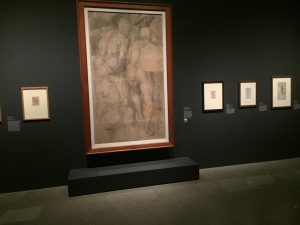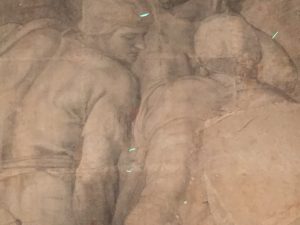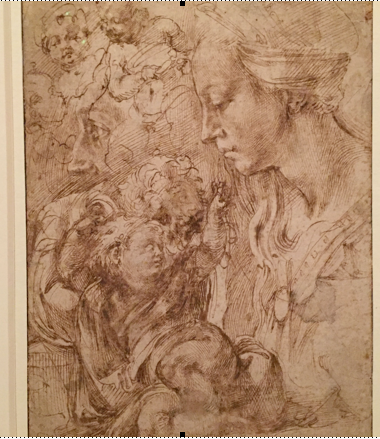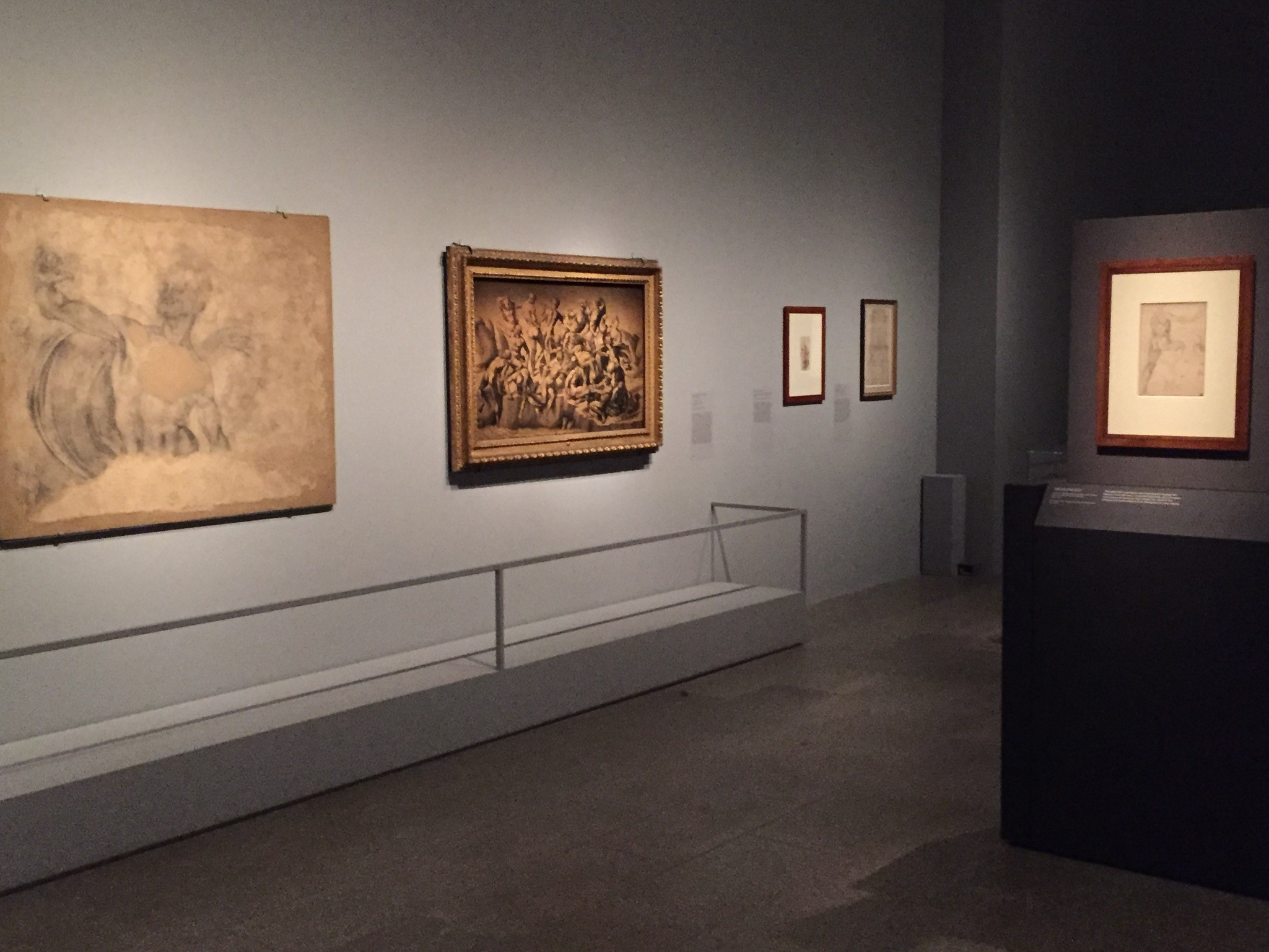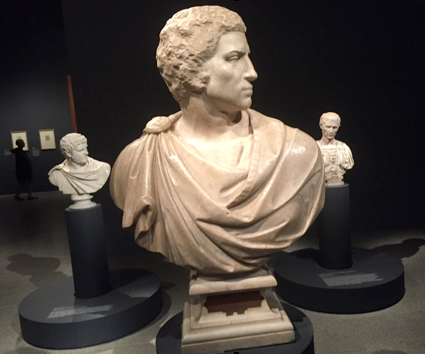“Michelangelo: Divine Draftsman & Designer” (The Metropolitan Museum of Art, November 13, 2017 – February 12, 2018)
Bernie Langs
The Metropolitan Museum of Art recently had on view an internationally acclaimed exhibition, “Michelangelo: Divine Draftsman & Designer”, which closed on February 12th. Of the 600 drawings attributed to the great genius of the Italian Renaissance, the show brought together 133 of them from all over the world, the largest number of such works ever assembled by the Master. In addition, the show offered a handful of sculptures by Michelangelo as well as many rare preparatory “cartoons” and one of his early paintings. Drawings, paintings, and sculptures from the hands of other great artists of the period, including those in Michelangelo’s inner circle, were on hand, along with art from other eras serving to drive home essential ideas about what influenced him and why. One of the larger galleries boasted a brightly lit, small-scale reproduction of the Sistine Chapel’s famous ceiling, which hovered above the large space. Many of the drawings in that room were studies for specific images from the Chapel and each of the placards highlighted exactly where you could locate them above on the ceiling. These included a preliminary sketch of God’s reaching arm for the touch that will enliven Adam’s soul, the faces and bodies of the Sybils (including the well-known sheet in the Met’s collection, Studies for the Libyan Sibyl), and a letter written by Michelangelo with a tiny self-portrait illustrating the physical misery of this huge undertaking.
Just days after I had seen the exhibit, the curator, Dr. Carmen C. Bambach, and Research Assistant Jeffrey Fraiman who was deeply involved with many of the logistics of the project, invited me for an afterhours viewing with only about 25 others in attendance. I jumped at the opportunity.
Given this chance of a lifetime, for what end would I use it? One of the first major exhibitions I had ever attended, was in 1980 at the Morgan Library, “Michelangelo and His World”, which brought together 41 of the Master’s drawings. I specifically recall my strategy on studying his drawings at that visit, and this time, I specifically chose to take the exact opposite approach to understand the profound ideas revealed by the drawings. One can demand that the works of art assist with the progression of one’s own personal theories in hope of completing aesthetic, spiritual, or mystical inner dimensions within the soul or psyche. Upon entry to the Michelangelo exhibition, I said to myself: “Rubbish to all that,” and dove in simply to look at the drawings in the hope of experiencing what Kenneth Clark’s aptly calls “Moments of Vision”.
The Michelangelo exhibition gave its audience a chance to discover hints of how a genius of the highest level worked out his ideas. Viewers can see first-hand how his creative process initiated, perhaps as a work on paper in charcoal or in the wonderful textures induced by red chalk, and ended up as the sublime perfection of the frescoes in the Vatican or the perfect sculptures of The David or The Moses. The long-dead Michelangelo can’t go on camera and reveal how he did it so we are left in the uncomfortable situation of having to imply what his thinking process may have been by examining the clues he left behind and mixing them with tales of his personality gleaned from the reports at the time about his life or writings of his friends, such as Girogio Vasari in “The Lives of the Artists”.
The Met’s staff, including Dr. Bambach and Mr. Fraiman, do the tireless groundwork for all of us prior to our visit. They comb through the complicated historical record and centuries of scholarship, subsequently devising and writing up their theories. Dr. Bambach and Mr. Fraiman and their colleagues perform the Herculean task of condensing centuries of study and ideas so that their impressively educated passion sparks the hearts and minds of each one of the more than 600,000 people who viewed show.
A sheet of paper in one of the first galleries held numerous drawn studies of varying images by Michelangelo, some popping into the viewer’s eyes seemingly out of nowhere and retreating as another one emerged in its place. The drawing was crammed tight with idea after idea. On one side, I found of great interest an incomplete profile of a man buried in all the images of faces and bodies, fabulous in solid, confident detail, yet unusually halted in its progression. Other drawings in nearby galleries had isolated sketches on the same page floating in their own spatial realms and aesthetic dimensions, worked out by strokes of chalk, charcoal or pen. Many drawings were fully formed, or at times, there would be a section of a lightly present image next to another in sharp detail, reminiscent of da Vinci’s obsessive sketches in his famous notebooks.
Two of the rare works in the exhibition were large planning “cartoons”, one a section of a preparatory drawing for Michelangelo’s Vatican frescoes, depicting a detail of Roman soldiers for The Crucifixion of Saint Peter in the Pauline Chapel. The second was a design attributed to the Master and his workshop for Michele di Jacopo Cosini’s painting, Venus Kissing Cupid (the finished painting was also on view). The Vatican fragment left me engulfed in pure amazement and overwhelming awe. The Pauline paintings in the Vatican are of a completely different nature than the Sistine Chapel’s ceiling and Last Judgement wall. They seem to present an intense inner contemplative expression of Michelangelo’s suffering and spiritual conflicts. The frescoes have a tightness and harsher spatial reality of personal tortured reality than the grand images in the Sistine. Yet the cartoon at the Met had aspects of softness and clarity not apparent in the completed project.
Other highlights of the exhibition included a powerful sculpted bust depicting Brutus, displayed alongside an ancient Roman sculpture of a similarly posed emperor. There was also a sublime unfinished sculpture ambiguously titled, Apollo-David, similar in its chiseled texture to the unfinished Deposition in Florence in which a self-portrait of Michelangelo appears as Nicodemus. These sculptures are fabulously rough as opposed to the polish of Pietà in Saint Peters in Rome.
A room with red chalk drawings of unparalleled genius had depictions of emotional subjects such as Study for a Descent from the Cross and the dynamic display of Archers Shooting at a Herm. I found myself incapable of thinking about anything besides their exceptional power and beauty. I also found myself returning a number of times to gaze at the Unfinished Cartoon of the Virgin and Child. The face of the Madonna is similar in its features to many of the faces in the frescoed Sistine Chapel. The delicacy of the figure is ethereal, almost beyond physical reality, and well past thoughts of flesh and blood, perhaps created in the Master’s mind from his vision of the Platonic form of feminine beauty itself. His ideal became the blueprint for artists of the time in representing the divine in the guise of paint.
Michelangelo was a captive of the times in which he lived, as we all are. He had to create within the confines of the ideas, society, culture, and territorial realities of Italy during his lifespan of 1475-1564. Michelangelo guided art into a new paradigm reaching untold heights and revealing realms of ideas and thoughts on all manners of subjects, both human and spiritual in nature. We can all thank him for his efforts as well as those who continue to study the works of all of the greats and present them to us for the betterment of Mankind.
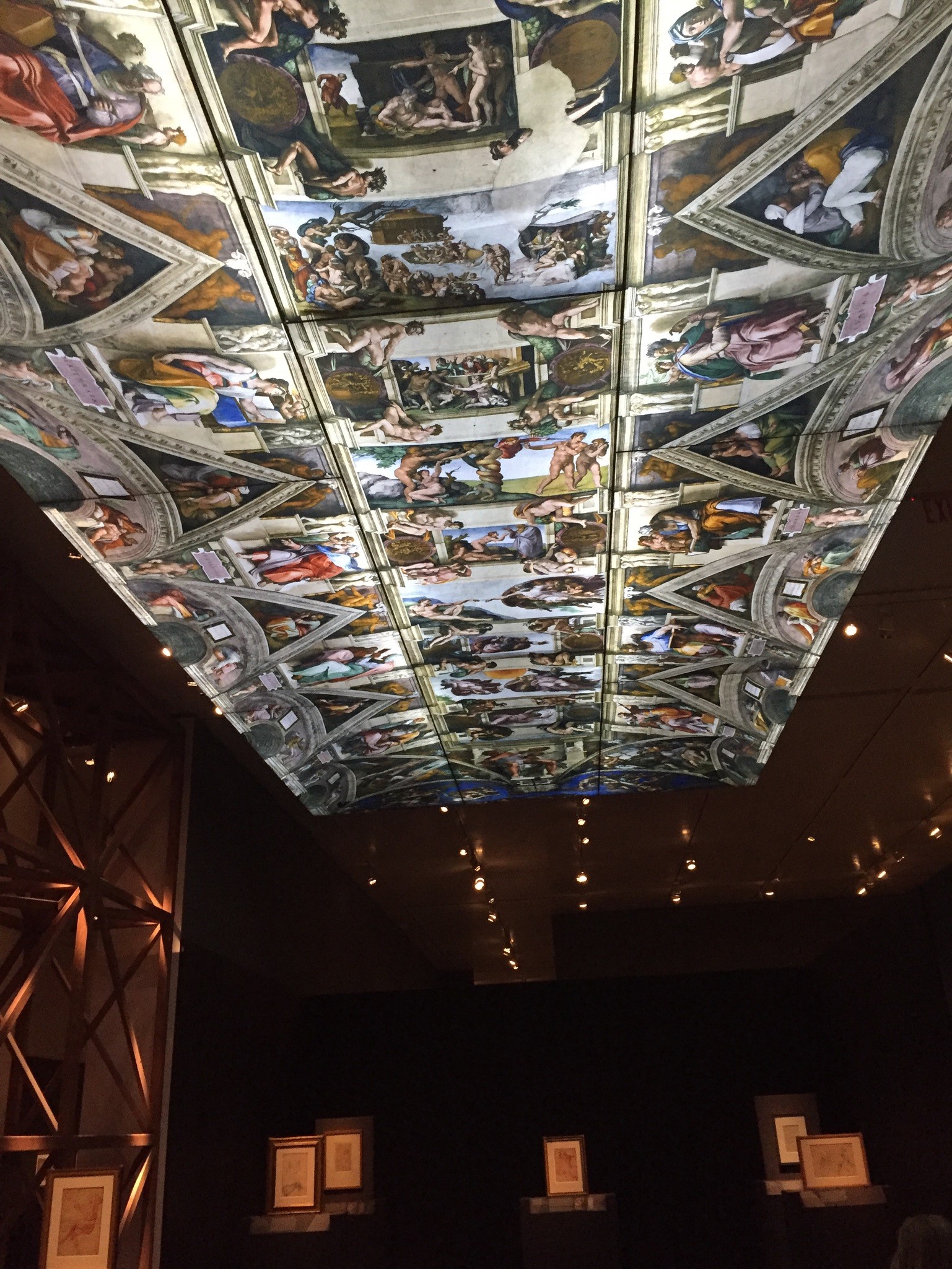 View of the Met Museum’s recreated Sistine Chapel with related drawings on display.
View of the Met Museum’s recreated Sistine Chapel with related drawings on display.
Michelangelo Buonarroti Roman Soldiers, Cartoon Fragment for the Lower Left Part of the Crucifixion of Saint Peter in the Pauline Chapel. Charcoal, with some black chalk, on approximately nineteen sheets of paper, outlines pricked for transfer. Museo Nazionale di Capodimonte, Gabinetto Disegni e Stampe, Naples (and detail).
Michelangelo Buonarroti Sketches of the Virgin, the Christ Child Reclining on a Cushion, and Other Sketches of Infants. Pen and brown ink. Staatliche Museen zu Berlin, Kupferstichkabinett.
LEFT: Mural Fragment of a Male Nude in Three-Quarter Length (Triton or Satyr). Charcoal on rough porous plaster. Sernesi Family, Villa Michelangiolo, Settignano;
CENTER: Bastiano (Aristotile) da Sangallo (Italian, 1481–1551). Copy after the Central Episode of the Bathers in Michelangelo’s Battle of Cascina.
Michelangelo Buonarroti (with slight retouching by a later hand in pen and ink). Unfinished Cartoon of the Virgin and Child. Black chalk, red chalk, traces of brush and brown wash, with lead-white gouache highlights. Casa Buonarroti, Florence.
Michelangelo Buonarroti with some assistance by Tiberio Calcagni Bust of Brutus (unfinished). Carrara marble. Museo Nazionale del Bargello, Florence.
View of the two galleries of the Met Museum’s exhibition “Michelangelo: Divine Draftsman & Designer”.

